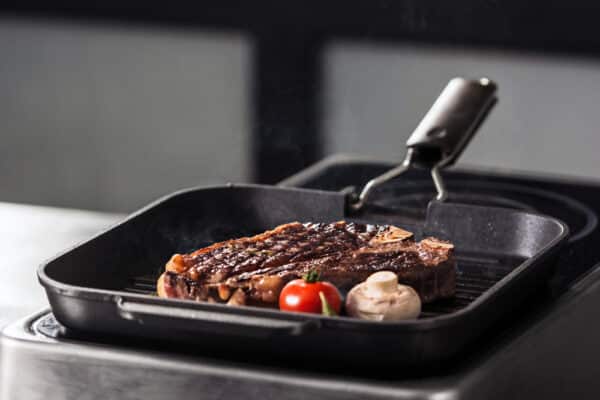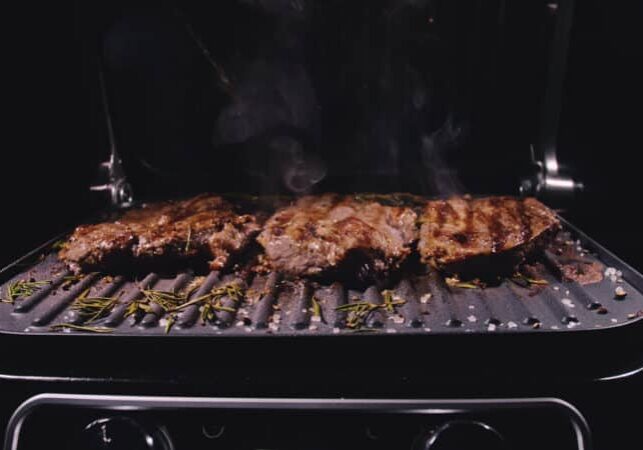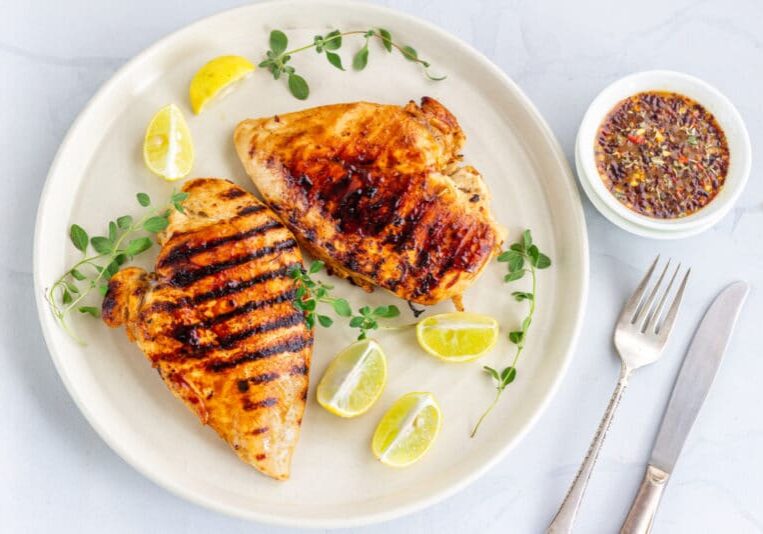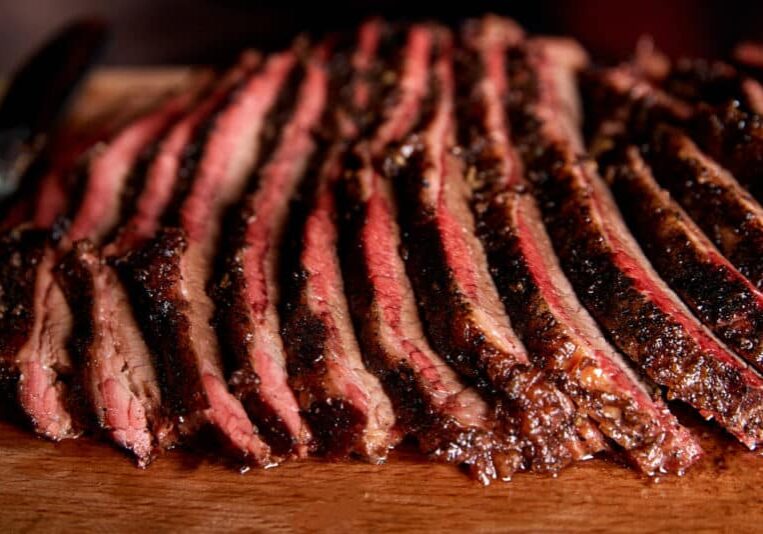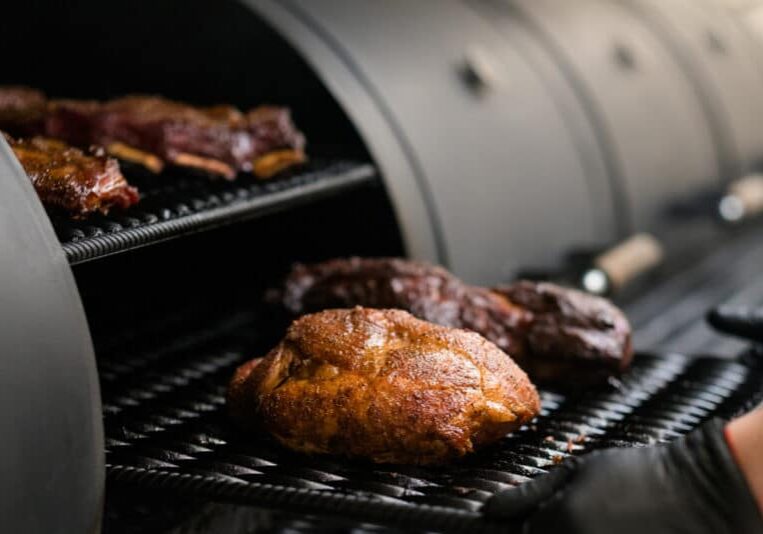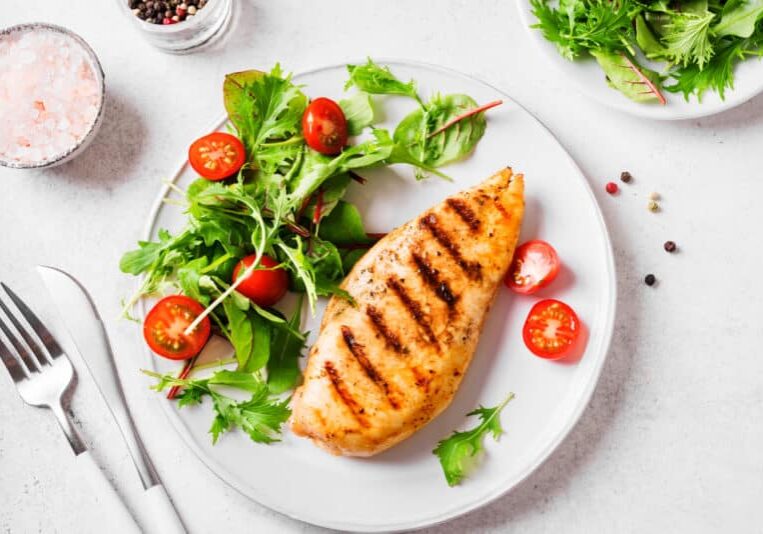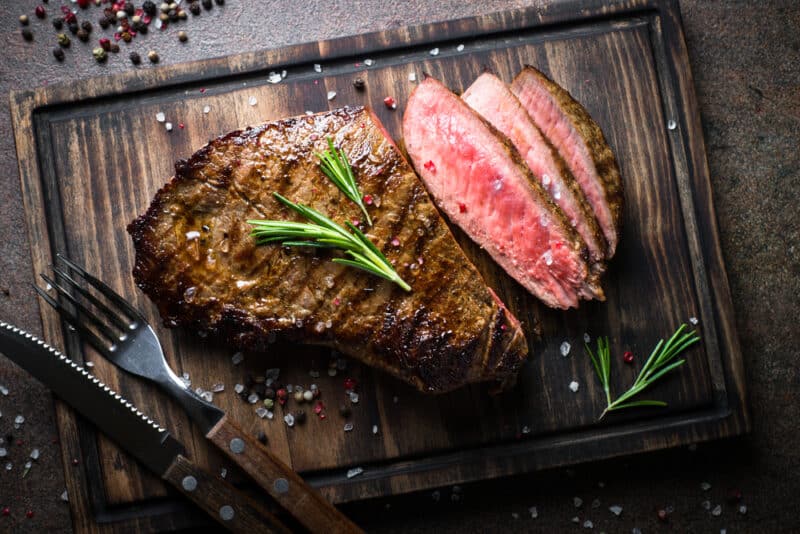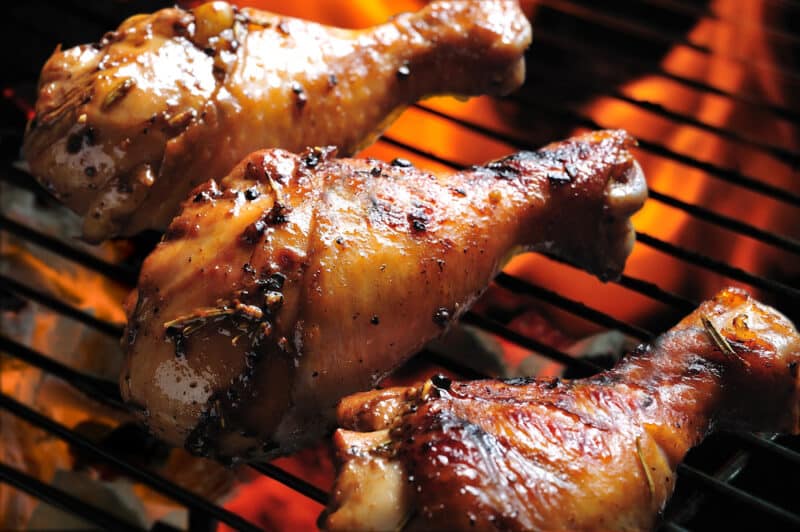How to Reheat Steak [Get Max Flavor]
TheGrillingMaster.com is reader-supported. If you buy something using the links on our site, we might earn an affiliate commission at no added cost to you. This helps us pay our staff to keep making awesome content for you!
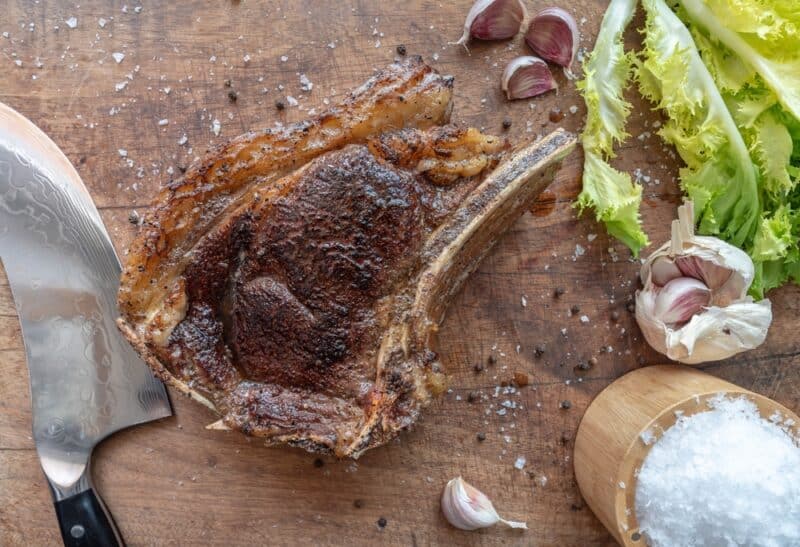
To reheat steak can be a tricky task as it tends to quickly lose its moisture and taste. Overcooking it can make it dry and rubbery, while undercooking can leave it cold in the center.
Juiciness is a crucial factor that we all look for in a grilled steak, but it evaporates when combined with heat and moisture.
This article discusses various methods to reheat steak, each with its advantages and disadvantages. By monitoring the process appropriately, you can enjoy the reheated steak just as much as the first time.
Having leftover steak can be a lifesaver when you need a quick and satisfying meal.
One delicious option for breakfast is to warm up a few slices and serve them with scrambled eggs for a hearty steak and eggs dish.
Pre-sliced steak is also a great ingredient to have on hand for easy fajitas, making dinner prep a breeze.
With these ideas, you can elevate your meals with minimal effort and enjoy the deliciousness of steak even after the initial meal.
The Best Method for Reheating Steak
You can heat your food from the outside to the inside when using an oven. However, you will risk dehydrating the steak.
Similarly, contact heating utilizes a single hot surface, such as searing steaks in a pan. Although this is a quick method, uneven heating is possible.
On the other hand, the microwave heats food from the inside out by energizing the water molecules. It also comes with the risk of ruining your food’s texture.
Reheating steak can be done in a variety of ways, but the best method depends on whether you’re making individual slices or big cuts.
Below you’ll find several methods for reheating steak, each with pros and cons, to help you choose the best method.
However, first things first. We must deal with the food safety aspects before everything else because if not done properly, a juicy steak can hide dangerous pathogens.
Related Reading >> How Long Does Prime Rib Last in the Fridge?
Food Safety to Prevent Food-Related Illnesses
Ensuring that food is cooked to the minimum safe temperature is crucial to prevent the consumption of harmful bacteria.
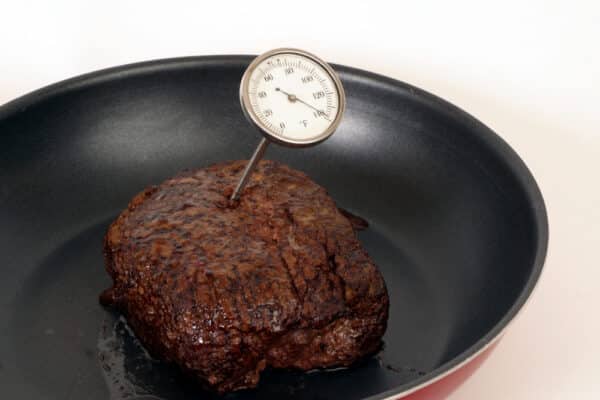
Measure the internal temperature with a meat thermometer
When it comes to steak, the bacteria are only present on the surface and cannot penetrate the muscle tissue. Hence, heating the surface to a high temperature will neutralize them, making the steak safe to eat even when it is rare.
However, if the steak is not stored properly and is exposed to the “Danger Zone” between 40°F and 140°F, the bacteria can reappear. Therefore, it is essential to store uneaten steak in the fridge or freezer promptly.
If you stored the leftover steak in the freezer, defrosting the steak increases the food poisoning risks. Here you can read how to defrost steak.
To make your leftover steak safe for consumption, it is important to heat the surface to a temperature above 140°F.
The internal temperature is not a safety concern, but no one wants a cold center in their steak. However, the challenge is how to heat both the inside and the outside of the steak without sacrificing the taste and texture.
1. How to Reheat Steak in the Oven
When it comes to reheating thicker steaks like ribeye, the oven is the best method for maintaining the juicy crispy texture. Especially if you sear it in a very hot skillet after reheating it in the oven.
- Bring the steak to room temperature, keeping in mind that bacterial growth occurs as soon as the meat’s temperature passes 40°F. Bacteria can double within 20 minutes!
- Preheat your oven to 250°F with a rimmed baking sheet and a wire rack inside. The lower, gentler temperature will help reheat the steak from the inside out while maintaining the juices.
- Once the oven is hot, place the steak on the cooling rack in the oven to allow the circulation of air and heat from all sides. It will also prevent the steak from sitting in a pool of fat.
- Reheat the steak for about 20 minutes. Place the steak in the oven for about 20 to 30 minutes, or until a meat thermometer registers an internal temperature of about 100 to 110°F. Keep in mind that the time needed to reheat will depend on the thickness of your cut of steak.
- Optional: In the meantime, heat a medium frying pan or cast-iron skillet on the stovetop until it is searing hot.
- Swirl a tablespoon of vegetable oil in the pan, and when the oil is smoking hot, add the steak.
- Quickly sear the steak for about 60 to 90 seconds on each side to recreate the crispy, crunchy crust.
- Allow resting for 5 to 10 minutes before slicing or serving
PROS |
|
CONS |
|---|---|---|
|
This is the simplest method for reheating steak. |
|
The steak will stay moist and juicy, but it will lose the seared crust it once had. |
|
Hands-off, there is no flipping involved. |
|
It is only suitable for large, whole steaks. |
|
You only need to monitor the internal temperature. |
|
The reheating method will vary for sliced or cubed steak. |
|
There’s not much clean-up to do. |
2. How to Reheat Steak on the Stovetop
If you want to warm up skirt steak, flank steak, or other thinner pieces of steak, the stovetop might be the best way to go. This method is perfect if you’d like to reheat slices, cubes, or small bits of steak.
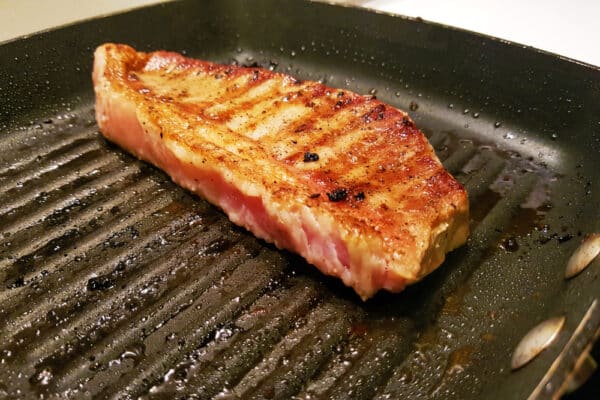
Stovetop Searing
As with the other methods to reheat steak, low and slow is best.
- Bring the steak to room temperature, keeping in mind that bacterial growth occurs as soon as the meat’s temperature passes 40°F. Bacteria can double within 20 minutes!
- Preheat a nonstick or cast-iron skillet over medium-low heat.
- Once it is warm, add the steak and any jus there might be. If there is no juice, add a splash of beef stock or drizzle it with a bit of neutral oil.
- Cover the skillet with a lid and reduce the heat to low. Check the internal temp at 3 to 5-minute intervals, until the meat is 110°F.
- Remove from the pan and wipe the pan clean of any juices.
- Add a splash of olive oil and heat the skillet over medium-high heat. Once hot, add the steak and sear on each side for about 60 to 90 seconds, until crisp.
- Let the meat rest to retain its juices for about five minutes before serving.
PROS |
|
CONS |
|---|---|---|
|
Fast, so if you’re pressed for time, this might be the best option. |
|
Thick medium-rare or rare steaks will likely be medium-well or well done by the time heated. |
|
It is the best way to reheat sliced or cubed steak leftovers. |
|
It is only suitable for thin steaks like sirloin. |
|
This method leaves your oven free for other cooking. |
|
At 375°F to 449°F moisture may be lost. |
|
You’ll need no more than a skillet. |
3. How to Reheat Steak in the Air Fryer
Much like a convection oven, an air fryer operates with air and heat swirling from all sides, making them great for reheating steak. Unlike a conventional oven, air fryers take a fraction of the time, crisping it up at the same time. This method will ensure your perfect steak is as good the second time as the first time.
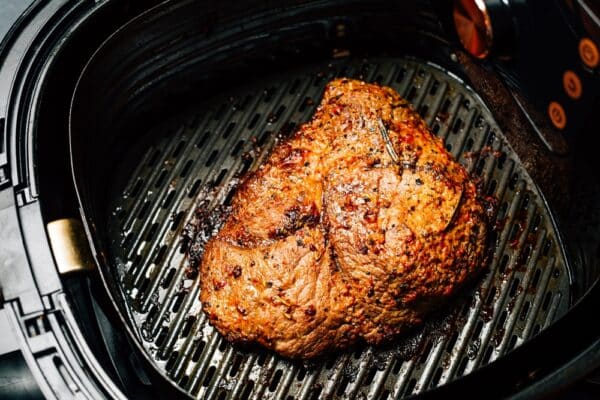
Air Fryer Method
- Preheat the air fryer to 350 degrees Fahrenheit.
- Unlike the other methods, you don’t need to get the leftover steak to room temperature when you use an air fryer.
- Add the steak to the air fryer basket or tray if you have an air fryer oven.
- Allow the steak to cook for three to five minutes depending on the size of the cut of meat and add a minute or two for particularly thick pieces. It’s best to monitor the internal temperature to prevent overcooking. You want it to be about 110°F.
- Once the desired heat is reached, remove the steak from the air fryer and let it rest for about 5 minutes.
- You might want to put a bit of garlic or herb butter on the steak and cover it with foil while it rests.
PROS |
|
CONS |
|---|---|---|
|
The circulating air also helps create a crispy crust and preserves color. |
|
The only negative is that you have to keep a close watch or risk overcooking it. |
|
You can reheat a steak within minutes. |
||
|
This method works for any kind or size of steak you’d like to reheat. |
||
|
It uses less energy than any other method. |
4. How to Reheat Steak in the Microwave
Reheating steak in the microwave is not highly recommended, and to be honest, it is my least favorite option. However, it is the fastest way to get the job done.
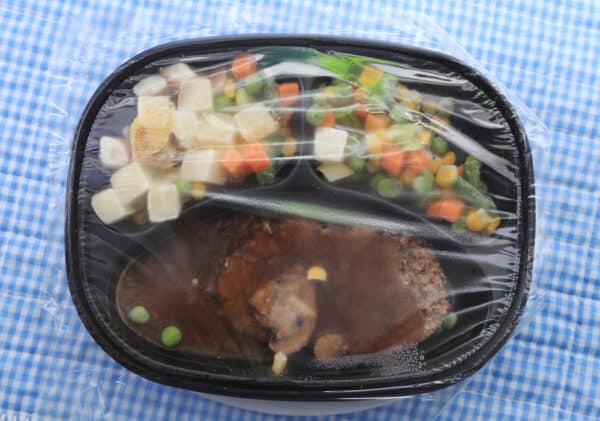
Microwave Method
Many people disagree with me, so the steps here are what they recommend.
- Remove the steak from the fridge and let it warm up to room temperature, keeping in mind that bacterial growth occurs as soon as the meat’s temperature passes 40°F. Bacteria can double within 20 minutes!
- Place the steak in a microwave-safe container and add any pan drippings. If your steak doesn’t have any juices left over, add a splash of beef stock to keep it from drying out.
- Cover the steak with a damp paper towel to further prevent it from drying out.
- Cover the container with plastic wrap or a microwave-safe lid.
- Set the microwave to 50 percent power and heat in 30-second increments just until warmed.
- Flip the steak after each interval.
- Monitor the internal temperature, and remove it from the microwave when it reaches 110°F.
- The amount of time depends on the thickness and size of the steak, but it will likely need no longer than about 2 minutes.
- Let the meat rest for about five minutes before serving. This will help the meat retain its juices.
PROS |
|
CONS |
|---|---|---|
|
This is by far the fastest and simplest method to reheat a steak. |
|
While your steak is warm, the texture and taste just won’t be the same. |
|
|
Steak can be overcooked, dry, chewy, and have a soggy crust within seconds |
|
|
|
The slightest distraction can cause the steak to be ruined. |
|
|
|
Large, thick steaks will become chewy and dry with the extra time required. |
5. How to Reheat Steak Sous Vide-Style
Sous vide is a French technique that uses a warm water bath to gently cook food in a vacuum-sealed freezer bag. It is also a way to reheat steak without the risk of it losing moisture.
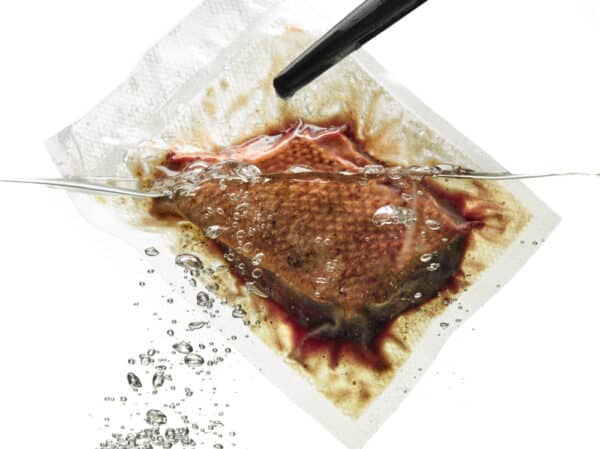
Sous vide method
However, like me, most home cooks do not have such a fancy piece of equipment as a Sous Vise Machine. Here I will explain the DIY method I use to get the same result.
- Use a pot large enough for the steak or steaks you want to reheat.
- Fill it with water and place it on the stovetop.
- Maintaining the water temperature at 130°F is crucial for this method, so you’ll need a digital thermometer and a heat-resistant clip to clamp the thermometer to the edge of the pot to give a constant readout.
- Use a low heat setting to bring the water up to 130°F.
- While the water heats, seal each steak inside a waterproof or vacuum bag, adding a bit of butter to each bag.
- When the water reaches the required temperature, use more clips to clamp the bags with steaks to the rim of the pot, making sure they are completely submerged.
- Keep in mind that adding the cold steak will drop the water temperature, so you may need to adjust the heat level.
- Monitor your water temperature throughout. keeping it within a couple of degrees of 130°F.
- Remove the steak from the water and check the internal temperature for doneness. You want it to be about 110°F. The time depends on the size of the steak, typically about 6 to 8 minutes.
- If you want your steak to have more color, you can give it a quick sear in a hot skillet.
PROS |
|
CONS |
|---|---|---|
|
By reheating at low temperatures, the steak is not directly exposed to heat. |
|
If you don’t own a sous vide machine, you have to keep tabs on the water temperature throughout to keep it steady. |
|
At 130°F, your steak can be kept to the doneness that it was before reheating. |
|
Losing control of the water temperature can cause overcooked steak. |
|
|
The slightest leak in the plastic bag could leave you with a soggy steak. |
6. How to Reheat Steak in Broth
This is a straightforward method to reheat steak.
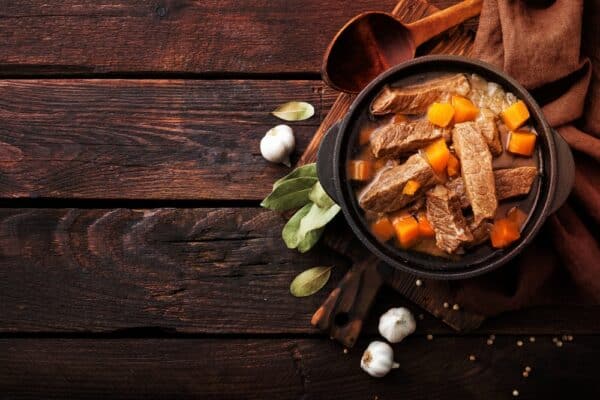
Steak reheated in Beef Broth
- Add some beef broth to a pan and heat the broth for 1 to 2 minutes until it comes to a boil.
- Add your steak and cook it gently on medium heat.
- Flipping the steak every minute.
- Cook it until you think it is ready to eat. Use a meat thermometer to check the internal temperature. You’d want it to be about 110 degrees Fahrenheit.
- Once done, remove your steak and serve immediately.
PROS |
|
CONS |
|---|---|---|
|
The broth will prevent the steak from becoming rubbery. |
|
If you cook it in the broth for too long, it will lose flavor and become tasteless. |
|
The steak will not dry out. |
|
Medium-rare and rare steaks will quickly become medium or medium well. |
|
It is an easy process. |
Related Reading: See how to prepare and cook flank steak.
Frequently Asked Questions
Q: Can you reheat steak?
A: Yes, you can reheat steak.
Q: What is The Best Way to Reheat Steak?
A: The best way to reheat steak is to use an oven or a grill. You can also use a microwave or a stovetop, but these methods may not be as effective.
Q: Is Reheating Steak Safe?
A: Yes, if you kept the leftover steak in the refrigerator and did not give it a reason to spoil, like leaving it at room temperature instead of refrigerated. You can also reheat frozen steak, use our guide here.
Q: Is Reheated Steak Good?
A: A reheated steak can be tasty, depending on the reheating method chosen. If done correctly, it will not lose flavor, moisture, and tenderness.
Q: Is Leftover Steak Good Cold?
A: Yes, cold leftover steak is generally considered tasty, and can be used for sandwiches, salad, and more. However, remember that leftovers should be stored safely in the refrigerator and eaten as soon as possible.
Q: Is reheated steak still good for you?
A: Yes, reheated steak has the same nutritional benefits, like providing your body with iron and other micronutrients, as freshly cooked steak.
Q: Should I reheat steak at low or high temperatures?
A: Low and slow is the rule of thumb, whether using the oven, microwave, or sous vide method, but higher when searing the steak in a skillet, or using an air fryer.
Q: Is it safe to let leftover steak warm up to room temperature before reheating it?
A: Yes, any pathogens will be on the outside surface of the steak, and will be destroyed during the heating process.
Q: How long can leftover steak be left on the countertop to get to room temperature?
A: Perishables can be left out for up to 2 hours, but 30 minutes should be enough to get the steak to room temperature.
Learn More About Grilling
If you want to learn more about grilling, check out these other helpful resources!

Kevin Turner
Hi there, I'm Kevin Turner, Founder and CEO of thegrillingmaster.com. I started this website to share my passion and knowledge with you. You can leverage my years of experience as a pit master and professional to grill great food!
About The Grilling Master
Hi there, I'm Kevin Turner, Founder and CEO of thegrillingmaster.com.
My passion has always been grilling, smoking and BBQ delicious meats that satisfy my inner carnivore!
I started this website to share my passion and knowledge with you, the hungry reader who wants to prepare the perfect meal.
You can leverage my years of experience as a pit master and professional.
Send me a message and let's connect on Twitter here.


